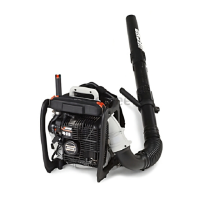What to do if Echo Blower engine cranks but there is no fuel at cylinder?
- VValerie JohnsonSep 8, 2025
If the Echo Blower engine cranks but won't start because there's no fuel at the cylinder, consult your Echo dealer for assistance.

What to do if Echo Blower engine cranks but there is no fuel at cylinder?
If the Echo Blower engine cranks but won't start because there's no fuel at the cylinder, consult your Echo dealer for assistance.
What to do if Echo PB-610 engine does not crank because of an internal engine problem?
If the Echo Blower engine does not crank and you suspect an internal engine problem, consult your Echo dealer for assistance.
What to do if Echo Blower engine runs, but blower doesn't work because pipe is clogged?
If the engine runs, but the Echo blower doesn't work because the pipe is clogged, unclog the pipe.
What to do if Echo PB-610 engine runs, but blower doesn't work because pipe is loose?
If the Echo Blower engine runs, but the blower doesn't work because the pipe is loose, tighten the pipe.
What to do if Echo PB-610 Blower engine runs, but blower doesn't work because pipe is damaged?
If the engine runs, but the Echo blower doesn't work because the pipe is damaged, replace the pipe.
Why does my Echo Blower engine run, but the blower doesn't work or is weak/uneven?
If the engine of your Echo Blower runs, but the blower doesn't work or is weak/uneven, check the following: * The pipe may be clogged. Unclog it. * The pipe may be loose. Tighten it. * The pipe may be damaged. Replace it.
Read and understand this manual for specifications, operation, starting, stopping, maintenance, storage, and assembly.
Explanation of safety alert symbols, key words, and their meanings for safe operation and unit protection.
Visual symbols used in the manual and on the product, with their corresponding descriptions and applications.
Guidelines on physical condition, required safety gear, and proper clothing for safe operation of the power blower.
Guidelines on physical and mental well-being, eye, hand, and breathing protection for safe operation.
Recommendations for appropriate clothing, footwear, and managing hot humid weather and cold exposure.
Precautions related to Raynaud's Phenomenon from vibration and cold, and recommended actions.
Tips to reduce the risk of RSI/CTS, including wrist position, breaks, exercises, and seeking medical advice.
Warning against operating indoors or in poorly ventilated areas due to poisonous engine exhaust.
Guidelines for clearing the work area, maintaining a firm grip, solid stance, and avoiding hot surfaces.
Instructions for checking the unit for loose parts, damage, and using approved attachments and parts.
Details on EPA Phase 2 / C.A.R.B. TIER III emission control systems and product emission durability.
Locate and understand safety decals on the unit for proper instructions. Replace illegible decals.
Information regarding the sound level measurement and classification of the blower.
Descriptions of key components of the power blower, such as air cleaner, spark plug, and throttle handle.
A list of all items included in the blower package, including the unit and accessories.
Step-by-step guide for assembling the blower pipes and attaching the stick handle, ensuring secure connections.
Warnings related to moving parts, sparks, and fire prevention during operation.
Specifications for gasoline octane, ethanol content, and approved two-stroke engine oil for the blower.
Critical safety warnings regarding fuel's flammability and safe handling practices.
Instructions for correctly mixing fuel and oil, and guidelines for safe fuel storage.
Step-by-step instructions for starting a cold engine, including throttle, choke, and recoil starter use.
Procedure for starting a warm engine, noting differences from the cold start process.
Instructions on how to properly stop the engine using the throttle lever and stop switch.
Warnings about hot exhaust, CO gas, and general safety precautions during blower operation.
Guidance on setting engine speed, using appropriate speeds for tasks, and minimizing noise and dust.
A table outlining maintenance tasks, required skill levels, and recommended intervals for various components.
Explanation of letter codes (I, R, C) used in the maintenance intervals table to denote inspection, replacement, and cleaning.
Detailed steps for inspecting, cleaning, or replacing the air filter element to ensure proper engine performance.
Instructions for safely removing and replacing the fuel filter in the fuel tank.
Steps for inspecting, cleaning, or replacing the spark plug and setting the correct spark gap.
Procedures for cleaning the cooling system components to prevent overheating and engine seizure.
Instructions for removing, cleaning, and inspecting the spark arrestor screen for carbon deposits and damage.
Steps to clean carbon deposits from the cylinder exhaust port using non-metal tools to avoid damage.
Information on engine break-in requirements and factory carburetor settings for different altitudes.
Identification and function of the idle speed, low speed, and high speed adjustment screws on the carburetor.
Detailed procedures for performing initial and final adjustments to the carburetor for optimal performance.
A chart listing common problems, their causes, and recommended remedies for the power blower.
Comprehensive steps for preparing the unit for long-term storage, including draining fuel and lubricating the engine.
Detailed technical specifications for the ECHO PB-610 Power Blower, including dimensions, weight, and performance metrics.
Information on obtaining genuine ECHO parts and identifying the unit's model and serial numbers.
Contact information and hours for ECHO Consumer Product Support for assistance with operation and maintenance.
Instructions for warranty registration and obtaining additional manuals or safety videos.